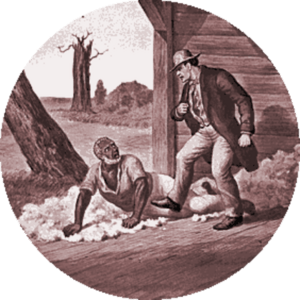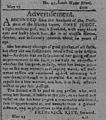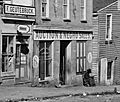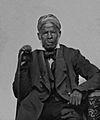Slavery in the United States facts for kids
Slavery in the United States dates back to the early colonial period when Europeans first settled in what later became the United States. Slavery was practiced in Britain's colonies, including the Thirteen Colonies that formed the United States. Under the law, an enslaved person was treated as property that could be bought, sold, or given away. Enslaved people had to work without pay and were not allowed to make their own choices. They were forced to work on farms and plantations growing crops like tobacco and cotton, in homes, and in other jobs, often under very harsh conditions. They were often whipped or beaten if they didn't work fast enough or if they tried to resist.
Enslaved people had very few rights. They couldn't own property, learn to read or write, or travel without permission. They were not allowed to marry legally, and their families could be separated at any time.
Many people in the United States believed slavery was wrong and worked to end it. These people were called abolitionists. Famous abolitionists included:
Slavery lasted in about half of U.S. states until abolition in 1865.
Slavery was a dark chapter in American history, but learning about it helps us understand how far we've come and how important it is to treat everyone with fairness and respect.
Contents
How did slavery start in America?
Slavery began in the early 1600s when European settlers in North America needed workers for their farms and plantations. At first, they used indentured servants (people who worked for a set number of years to pay off a debt), but later they turned to enslaving Africans. The first enslaved Africans arrived in Jamestown, Virginia, in 1619.

During most of the British colonial period, slavery existed in all the colonies. People enslaved in the North typically worked as house servants, artisans, laborers and craftsmen, with the greater number in cities. Many men worked on the docks and in shipping. Enslaved people were also used as agricultural workers in farm communities, especially in the South, growing indigo, rice and tobacco (cotton did not become a major crop until after the 1790s). In 1720, about 65 percent of South Carolina's population was enslaved.
Slavery in the American Revolution
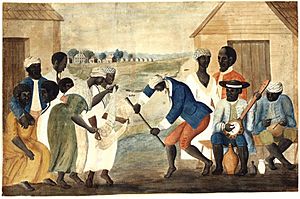
After the Revolutionary War broke out, the British realized they lacked the manpower necessary to prosecute the war. In response, British commanders began issuing proclamations to Patriot-owned slaves, offering freedom if they fled to British lines and assisted the British war effort. Such proclamations were repeatedly issued over the course of the conflict, which resulted in up to 100,000 American slaves fleeing to British lines. Self-emancipated slaves who reached British lines were organized into a variety of military units, which served in all theaters of the war. Formerly enslaved women and children worked as laborers and domestic servants.
Many slaves took advantage of the disruption of war to escape from their plantations to British lines or to fade into the general population. In the closing months of the war, the British evacuated freedmen and also removed slaves owned by loyalists. Around 15,000 black loyalists left with the British, most of them ending up as free people in England or its colonies.
Constitution of the United States
Slavery was a topic of contention at the 1787 Constitutional Convention. Many of Founding Fathers of the United States were plantation owners who owned large numbers of enslaved laborers. The words "slave" and "slavery" did not appear in the Constitution as originally adopted, although several provisions clearly referred to slaves and slavery. Until the adoption of the 13th Amendment in 1865, the Constitution did not prohibit slavery.
Although the enslaved of the early Republic were not permitted to vote, and had no rights to speak of, they were to be enumerated in population censuses and counted as three-fifths of a person for the purposes of representation in the national legislature, the U.S. Congress.
After the Revolution
In the first two decades after the American Revolution, state legislatures and individuals took actions to free slaves. Northern states passed new constitutions that contained language about equal rights or specifically abolished slavery. By 1804, all the Northern states had passed laws outlawing slavery, either immediately or over time. In New York, the last slaves were freed in 1827 (celebrated with a big July 5 parade). Indentured servitude, which had been widespread in the colonies (half the population of Philadelphia had once been indentured servants), dropped dramatically, and disappeared by 1800.
"A necessary evil"
In the 19th century, proponents of slavery often defended the institution as a "necessary evil". At that time, it was feared that emancipation of black slaves would have more harmful social and economic consequences than the continuation of slavery. On April 22, 1820, Thomas Jefferson, one of the Founding Fathers of the United States, wrote in a letter to John Holmes, that with slavery,
We have the wolf by the ear, and we can neither hold him, nor safely let him go. Justice is in one scale, and self-preservation in the other.
Whether slavery was to be limited to the Southern states that already had it, or whether it was to be permitted in new states made from the lands of the Louisiana Purchase and Mexican Cession, was a major issue in the 1840s and 1850s. It was addressed by the Compromise of 1850.
The compromise
- approved California's request to enter the Union as a free state
- strengthened fugitive slave laws with the Fugitive Slave Act of 1850
- banned the slave trade in Washington, D.C. (while still allowing slavery itself there)
- defined northern and western borders for Texas while establishing a territorial government for the Territory of New Mexico, with no restrictions on whether any future state from this territory would be free or slave
- established a territorial government for the Territory of Utah, with no restrictions on whether any future state from this territory would be free or slave
The Underground Railroad
The Fugitive Slave Act of 1850 required law enforcement and citizens of free states to cooperate in the capture and return of slaves. This met with considerable overt and covert resistance in free states and cities such as Philadelphia, New York, and Boston. Refugees from slavery continued to flee the South across the Ohio River and other parts of the Mason–Dixon line dividing North from South, to the North and Canada via the Underground Railroad. The Underground Railroad was a secret network of people who helped enslaved people escape to freedom. Some white Northerners helped hide former slaves from their former owners or helped them reach freedom in Canada.
Harriet Tubman was one of the most famous conductors on the Underground Railroad. She was an escaped enslaved person herself, and she made many trips back to the South to help others escape. She was known as the "Moses of her people."
Civil War
The issue of slavery caused a lot of tension between the northern and southern states. The southern states relied on slavery for their economy, while the northern states did not. This tension led to the Civil War in 1861. During the war, President Abraham Lincoln issued the Emancipation Proclamation in 1863, which declared that all enslaved people in the Confederate states were free.
The war ended on June 22, 1865, and following that surrender, the Emancipation Proclamation was enforced throughout remaining regions of the South that had not yet freed the slaves. Slavery officially continued for a couple of months in other locations. Federal troops arrived in Galveston, Texas, on June 19, 1865, to enforce the emancipation. The commemoration of that event, Juneteenth National Independence Day, was declared a national holiday in 2021.
Emancipation Proclamation
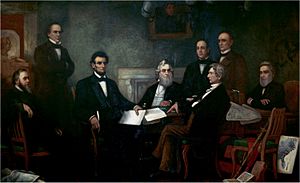
The Emancipation Proclamation was an executive order issued by President Abraham Lincoln on January 1, 1863. In a single stroke it changed the legal status of three million slaves in designated areas of the Confederacy from "slave" to "free". It had the practical effect that as soon as a slave escaped the control of his or her owner, by running away or through advances of federal troops, the slave's proclaimed freedom became actual. Plantation owners, realizing that emancipation would destroy their economic system, sometimes moved their slaves as far as possible out of reach of the Union army. By June 1865, the Union Army controlled all of the Confederacy and had liberated all of the designated slaves.
End of slavery
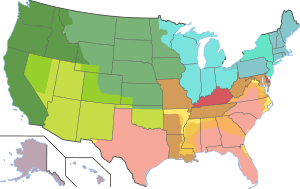
The Thirteenth Amendment, abolishing slavery except as punishment for a crime, had been passed by the Senate in April 1864, and by the House of Representatives in January 1865.

The amendment did not take effect until it was ratified by three-fourths of the states, which occurred on December 6, 1865, when Georgia ratified it. On that date, the last 40,000–45,000 enslaved Americans in the remaining two slave states of Kentucky and Delaware, as well as the 200 or so perpetual apprentices in New Jersey left from the very gradual emancipation process begun in 1804, were freed.
Interesting facts about slavery in the United States
- The Underground Railroad helped about 100,000 enslaved people escape to freedom.
- Harriet Tubman made 19 trips to the South and helped free over 300 people.
- The Emancipation Proclamation didn’t free all enslaved people right away—it only applied to states that were rebelling against the Union.
Important terms
- Enslaved People: individuals who were forced into slavery.
- Abolitionists: people who fought against slavery.
- Emancipation Proclamation: a document issued by President Lincoln declaring freedom for some enslaved individuals during the Civil War.
Images for kids
-
Slave auction block, Green Hill Plantation, Campbell County, Virginia, Historic American Buildings Survey
-
Ledger of sale of 118 slaves, Charleston, South Carolina, c. 1754
-
Prince Estabrook memorial in front of Buckman Tavern on Lexington Green in Lexington, Massachusetts. Prince Estabrook, who was wounded in the Battle of Lexington and Concord, was the first black casualty of the Revolutionary War.
-
This postage stamp, which was created at the time of the Bicentennial, honors Salem Poor, who was an enslaved African-American man who purchased his freedom, became a soldier, and rose to fame as a war hero during the Battle of Bunker Hill.
-
Advertisement in The Pennsylvania Gazette, May 24, 1796, seeking the return of Oney Judge, a fugitive slave who had escaped from the household of George Washington.
-
Confederate $100 bill, 1862–63, showing slaves farming. John C. Calhoun is at left, Columbia at right.
-
This portrait of Judge Samuel Sewall by John Smibert is in the Museum of Fine Arts, Boston Massachusetts.
-
Establishing the Northwest Territory as free soil – no slavery – by Manasseh Cutler and Rufus Putnam proved to be crucial to the outcome of the Civil War.
-
Statue of abolitionist and crusading minister Theodore Parker in front of the Theodore Parker Church in West Roxbury, Massachusetts.
-
Statue of prominent abolitionist Frederick Douglass in the Highland Park Bowl in Rochester, New York. Douglass was a great admirer of Theodore Parker.
-
Benjamin Kent, Old Burying Ground, Halifax, Nova Scotia
-
Henry Clay (1777–1852), one of three founders of the American Colonization Society, which assisted free blacks in moving to Africa. Liberia was a result.
-
Ashley's Sack is a cloth that recounts a slave sale separating a mother and her daughter. The sack belonged to a nine-year-old girl Ashley and was a parting gift from her mother, Rose, after Ashley had been sold. Rose filled the sack with a dress, braid of her hair, pecans, and "my love always"
-
Slave sale, Charleston, 1856
-
U.S. brig Perry confronting the slave ship Martha off Ambriz on June 6, 1850
-
Eastman Johnson's 1863 painting "The Lord is My Shepherd"
-
Slaves for sale, a scene in New Orleans, 1861
-
Mixed-race slave girls of predominant European ancestry, New Orleans, 1863 (see also white slave propaganda).
-
Five-dollar banknote showing a plantation scene with enslaved people in South Carolina. Issued by the Planters Bank, Winnsboro, 1853. On display at the British Museum in London.
-
Eastman Johnson (American, 1824–1906). A Ride for Liberty – The Fugitive Slaves (recto), ca. 1862. Oil on paperboard. Brooklyn Museum
-
Uncle Marian, a slave of great notoriety, of North Carolina. Daguerreotype of elderly North Carolina slave, circa 1850.
-
Slaves on J. J. Smith's cotton plantation near Beaufort, South Carolina, photographed by Timothy O'Sullivan standing before their quarters in 1862
-
Four generations of a slave family, Smith's Plantation, Beaufort, South Carolina, 1862
-
Many Native Americans were enslaved during the California Genocide by American settlers.
See also
 In Spanish: Esclavitud en los Estados Unidos para niños
In Spanish: Esclavitud en los Estados Unidos para niños


